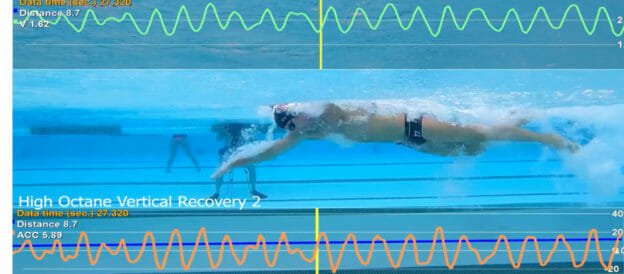Elevating the Core in Sprint Freestyle
Sprint freestyle is the fastest way of swimming. Therefore, it is also the one event where the swimmer’s technique is most important.
Technique is important in all swimming events and strokes, from the 50 meter freestyle to the 25k Open Water races. Regardless of the event distance or stroke, within the medium of water with its high density, frontal drag is the number one enemy of the racing swimmer. One bad drag-causing technique can ruin your day, particularly when it occurs over and over again.
Drag forces are proportional to at least the square of the swimmer’s speed. When dealing with wave drag, the drag is actually proportional to the fourth power of the swimmer’s speed. In other words, while sprinting, swimmers will pay a bigger penalty for poor technique, causing additional drag, than while making the same mistake at a slower speed in a longer distance event.
When testing Olympian sprinter Brad Tandy for some nuances of his freestyle technique, we compared his body position in the water by making one simple change, elevating his core. That is a technique that, unless the swimmer is really thinking about it, likely will not happen in a sprint.
No one would argue that a straight swimmer’s body has a lower drag-coefficient than a curved body. The real question is how do we keep the body straighter in the water while sprinting?
I liken the swimmer in the water somewhat to a horse standing up on all four legs. The horse is supported in the front by the front legs and in the back by the rear legs. In the middle, there is nothing really supporting the weight of the horse. As a result of gravity, there is always a little sway in the horse’s back. Over years, that sway can become significant.
Although the swimmer in the water with air in the lungs is weightless, not all of the body parts are weightless. The arms, legs and midsection of the well-conditioned swimmer’s body, which contain no air and are comprised of mostly muscle and bone, sink. There are really only three forces that help to keep the swimmer’s body straight and elevated in the water during freestyle – lift generated from the early pulling hands, the down kick from both feet, and buoyancy from the air in the swimmer’s lungs.
The midsection of the swimmer, however, from the upper legs to the diaphragm, is not supported by anything and so, from the force of gravity, tends to cause the lower back to sway slightly. That thought led to the theory that a swimmer who elevates the core while swimming, flexing very slightly at the waist, could possibly be in a straighter body position than a swimmer with more of a relaxed core.
We tested this hypothesis in Florida using our Drag Propulsion Meter (PDM) with elite swimmer, Nikola Obravac, and found the following. When we pulled Nikola across the 50 meter pool with his hands at his sides at an average speed of 2.308 meters per second, Nikola’s speed adjusted average drag forces were 206.75 Newtons with his normal body position and 187.89 Newtons with his core elevated and slightly flexed at the hip. That represents a 10% reduction of drag forces with the core elevated.
Recently we tested this hypothesis again, using Velocity Meter Technology (VM), and found the following. With his normal technique using his normal body position, Brad’s average freestyle sprinting velocity over approximately 10 meters was 1.917 m/sec and his Cycle time was 1.02 seconds (Stroke rate 118). With his core elevated, Brad’s average speed was 1.925 m/sec and his Cycle time was 1.04 seconds (Stroke rate 116).
With his core elevated, Brad increased his average sprint freestyle speed by .008 m/sec. Over 20 seconds of swimming time in the 50 meter sprint, that amounts to .16 meters or about a half a foot. As we have so often seen in the 50 meter races, that is enough to win or lose the race.
You can see the complete details of our testing with Brad on our video release for this week. When you swim your next sprint freestyle race, elevate your core, straighten your body position and get to the wall sooner.
Yours in Swimming,
Gary Sr.


Is this going to be the same for women, too? We tend to have strategic (floaty) fat deposits on the hips and lower back and a generally lower center of gravity. Would be really interesting to see what happens with a female swimmer.